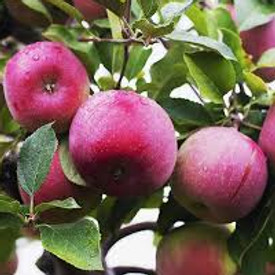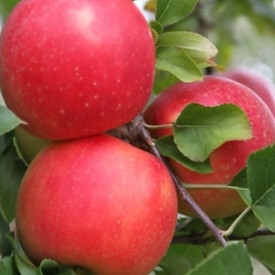



EARLY SEASON VARIETIES
Available Late August- Early September



Yellow Transparent
A crisp, light, and sweet apple is named for its pale yellow skin that matches its flesh. Great for making fresh applesauce!
Origin- Antique variety traced back to Russia, circa 1870.
Zestar!
A crisp + juicy apple that excites (!) with zesty flavor and a hint of brown sugar! These apples make the perfect packed snack as they retain their crisp, fresh flavor for 2 months when refrigerated!
Origin- Hybrid variety created by the University of Minnesota in 1999.
Pristine
These apples are mildly tart with a crisp bite. Good apples for fresh eating, baking, or making applesauce!
Origin- Born in the USA! Developed in Indiana in 1994.


Dandee Red
These apples are crisp, tart, and does not brown when cut! Like the Zestar!, Dandee Reds have can be stored for up to 3 months refrigerated.
Origin- Discovered growing off the limb of a Paula Red apple tree by Dan Simmons in Ohio, circa 1997.
Duchess
These medium sized apples are tender, crisp, and tart. Duchess apples are juicy and taste great when baked or dried!
Origin- Traced back to late 17th century Russia, the Duchess is named for Grand Duchess Catherine of Oldenburg, sister to Alexander I.

MID SEASON VARIETIES
Available Early- Late September

Premier Honeycrisp
Premier Honeycrisp is similar to Honeycrisp but ripens a few weeks earlier! These large, sweet + juicy apples taste like apple cider and are great for fresh eating, baking, or making applesauce.
Origin- Found growing on a Honeycrisp tree in August of 2010 at Mt. Ridge Farms Apple Orchard in Pennsylvania by the Slaybaugh family.

Ginger Gold
Apples great for eating fresh or in salads with a mild flavor with a surprising tart finish. Ginger Golds are generally considered one of the best early-season apples.
Origin- First discovered in Virginia in 1969 after Hurricane Camille washed out most of a Golden Delicious orchard with devastating floods. This new apple was one of the few trees left standing.

Kindercrisp
These apples share many qualities with their parent, the Honeycrisp, but are just the right size for little hands. The exceptional flavor, crisp bite, and small size make the perfect snack or addition to a child's lunch!
Origin- Developed by David MacGregor in Minnesota in 1998.

McIntosh
The McIntosh is a tender and tart all-purpose apple. Suitable for fresh eating, baking, or blending into juice!
Origin- Discovered by John McIntosh at his Canada farm in 1811 but suspected to have European origins as the Crabtree was the only native native apple in North America prior to settlement.

Ruby Mac
A medium-sized descendent of the McIntosh apple with a striking red color. The Ruby Mac has a wonderful sweet-tart balance and is juice, crisp, + very firm.
Origin- Discovered in Comstock Park, Michigan in 1999.

Honeycrisp
This apple is prized for its sweet yet tart flavor and crisp bite. Honeycrisps also tend to be more juicy than other apple cultivars due to their large cell size!
Origin- The Honeycrisp is the apple that almost wasn't! First developed in 1974 at the University of Minnesota, it was quickly shot down and slated to be discarded. It was officially released in 1991 and has been a hit ever since!

SnowSweet
With rich overtones and a perfect balance between sweet and tart, SnowSweet apples will delight the taste buds. They have a lovely snow white flesh and are great for snacking fresh or chopped in salads due to their resistance to browning.
Origin- Developed at the University of Minnesota and released in 2006.

Royal Empire
A cross between Red Delicious and McIntosh, the Empire is juicy and has a blended sweet-tart flavor. It is an all purpose apple, perfect for baking, freezing, fresh eating, or complimenting a salad.
Origin- Created at Cornell University (New York) circa. 1940.

Sweet 16
Sweet 16s live up to their name with a very sweet flavor, complimented by hints of citrus and vanilla. Some say they taste like cherry candy! These apples are juicy and have a nice crisp crunch. They are delightful for snacking, baking, or in a no sugar added applesauce!
Origin- Developed in 1973 at the University of Minnesota. It is a cross between a Frostbite and Northern Spy.

Cortland
Cortland apples are gorgeous ruby red in color with a white flesh that resists browning when sliced. They also are perfect for cider or pie!
Origin- Developed by Cornell University (New York) in 1898. It is specially well suited to the Great Lakes area because of its cold-hardiness.

Frostbite
These small apples pack a sweet punch! Frostbite apples were developed as a novelty apple because of their small size and unusual appearance. They are very sweet and are the perfect size for snacks or children's lunches. Frostbites also make great cider!
Origin- First discovered and fruited in 1921 but was not released until 2008 by the University of Minnesota. The apples later became a "grandparent" to Honeycrisp apples.

Kudos
Developed by crossing a Honeycrisp and Zestar!, the Kudos apple has a beautiful cherry red color. A sister to the Sweetango apple, it has an excellent crisp bite and has a well balanced flavor with occasional tropical overtones.
Origin- Kudos apples are the newest variety coming out of the University of Minnesota and have only been available commercially since 2022.


Haralson
Haralson apples are large, firm, and tart apples. They are wonderful for fresh eating or baking. They tend to hold their shape very well when sliced, so they are excellent apples for cooking pies but not applesauce.
Origin- Developed at the University of Minnesota in 1923 and named for Charles Haralson, the superintendent of the U of MN Fruit Breeding Farm.
Wolf River
These ENORMOUS apples are very popular for baking because you will only need one! The flesh is crunchy, somewhat juicy, and mildly sweet. This firm apple is similar to a Haralson and holds shape well when cooked. It is prized by many for apple butters!
Origin- Discovered in 1875 for the first time along the Wolf River in Wisconsin.

LATE SEASON VARIETIES
Available Late September- Mid October



Crimson Crisp
Named for its deep crimson color, these apples have a yellow flesh with a crisp and sweet taste. Makes a delicious, slightly pink cider or a great fresh snack.
Origin- Developed by Rutgers University Fruit Research and Development Center (New Jersey) in 1971.
Triumph
Apples with a pleasantly tart flavor. It is a firm apple that stores very well. This new variety out of U of MN is delicious for fresh eating.
Origin- Produced by the University of Minnesota in 2021, released to growers in 2022.
Ruby Rush
Deep red apples with a desirable crunchy bite and a balanced tart-sweet flavor. They are excellent for fresh snacking.
Origin- Ruby Rush is an exciting new release from the apple breeding program at Rutgers University in New Jersey. It was developed in 2020 but not released to growers until 2022.

Fireside
These medium sized apples are ideal for eating fresh or baking. They are fragrant and sweet, making them the perfect dessert apple!
Origin- Discovered in the heart of Minnesota in the 1940s, many believe they are named after the famous "Fireside Chats" delivered by President Roosevelt during this time.

Prairie Spy
A very sweet tasting apple with notes of honey flavor. It is medium-sized and makes a great dessert apple or fresh snack.
Origin- Prairie Spy apples are on of the first varieties developed at University of Minnesota, first planted in 1914. It became commercially available in 1940.